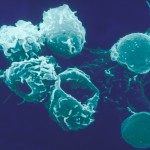Lien vers Pubmed [PMID] – 15906239
Int. J. Dev. Biol. 2005;49(2-3):251-7
For many years it has been assumed that the ontogeny of the mammalian hematopoietic system involves sequential transfers of hematopoietic stem cells (HSCs) generated in the yolk sac blood islands, to successive hematopoietic organs as these become active in the embryo (fetal liver, thymus, spleen and eventually bone marrow). Very little was known about early events related to hematopoiesis that could take place during the 4.5 day gap separating the appearance of the yolk sac blood islands and the stage of a fully active fetal liver. Experiments performed in birds documented that the yolk sac only produce erythro-myeloid precursors that become extinct after the emergence of a second wave of intra-embryonic HSCs from the region neighbouring the dorsal aorta. The experimental approaches undertaken over the last ten years in the murine model, which are reviewed here, led to the conclusion that the rules governing avian hematopoietic development basically apply to higher vertebrates.


